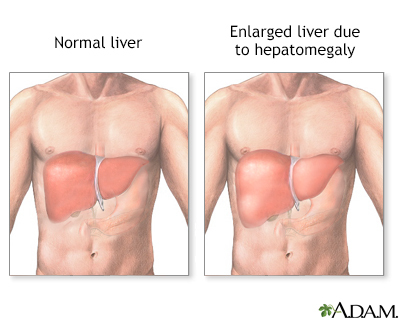Before and After: Christina’s Complete Transformation at UF Health
At her biggest, Christina Mandeville — a mother of three — was 350 pounds and suffering from multiple ailments. UF Health dramatically turned her life around,…

Update your location to show providers, locations, and services closest to you.
Hemochromatosis is a condition in which there is too much iron in the body. It is also called iron overload.
Iron overload; Blood transfusion - hemochromatosis
Hemochromatosis may be a genetic disorder passed down through families.
Hemochromatosis may also occur as a result of:
This disorder affects more men than women. It is common in white people of northern European descent.
Symptoms may include any of the following:
The health care provider will perform a physical exam. This may show liver and spleen swelling, and skin color changes.
Blood tests may help make the diagnosis. Tests may include:
Other tests may include:
The condition may be confirmed with a liver biopsy or genetic testing. If a genetic defect is confirmed, other blood tests can be used to find out if other family members are at risk for iron overload.
The goal of treatment is to remove excess iron from the body and treat any organ damage.
A procedure called phlebotomy is the best method for removing excess iron from the body:
Why the procedure is needed depends on your symptoms and levels of hemoglobin and serum ferritin and how much iron you take in your diet.
For people unable to undergo phlebotomy, medicines may be prescribed to reduce the body's iron.
Other health problems such as diabetes, decreased testosterone levels in men, arthritis, liver failure, and heart failure will be treated.
If you are diagnosed with hemochromatosis, your provider may recommend a diet to reduce how much iron is absorbed through your digestive tract. Your provider may recommend the following:
Untreated, iron overload can lead to liver damage.
Extra iron may also build up in other areas of the body, including the thyroid gland, testicles, pancreas, pituitary gland, heart, or joints. Early treatment can help prevent complications such as liver disease, heart disease, arthritis or diabetes.
How well you do depends on the amount of organ damage. Some organ damage can be reversed when hemochromatosis is detected early and treated aggressively with phlebotomy.
Complications include:
The disease may lead to the development of:
Contact your provider if symptoms of hemochromatosis develop.
Contact your provider for an appointment (for screening) if a family member has been diagnosed with hemochromatosis.
Screening family members of a person diagnosed with hemochromatosis may detect the disease early so that treatment can be started before organ damage has occurred in other affected relatives.

Bacon BR, Fleming RE. Hemochromatosis. In: Feldman M, Friedman LS, Brandt LJ, eds. Sleisenger and Fordtran's Gastrointestinal and Liver Disease: Pathophysiology/Diagnosis/Management. 11th ed. Philadelphia, PA: Elsevier; 2021:chap 75.
Brittenham GM. Disorders of iron homeostasis: iron deficiency and overload. In: Hoffman R, Benz EJ, Silberstein LE, et al, eds. Hematology: Basic Principles and Practice. 7th ed. Philadelphia, PA: Elsevier; 2018:chap 36.

At her biggest, Christina Mandeville — a mother of three — was 350 pounds and suffering from multiple ailments. UF Health dramatically turned her life around,…
